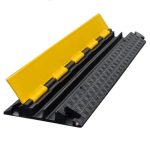Recycled rubber speed bumps are a reflection of modern-day engineering and eco-friendly ingenuity. They are a testament to the potential of recycled materials and the power of sustainable construction. One of the most significant aspects of these traffic calming devices lies in the materials used in their construction. Recognizing the importance of sustainability, numerous speed bumps suppliers now focus on incorporating recycled materials into their products. In this regard, we take a closer look at the solid materials used in building these eco-friendly speed bumps provided by these conscientious speed bumps suppliers.
The primary material used in the construction of these speed bumps is recycled rubber tires. This choice of material is not just about environmental sustainability but also about functionality and durability. Tires are designed to withstand friction and exposure to different weather conditions, making them perfect for speed bumps. The rubber is processed and molded into the desired shape, creating a durable and resilient traffic calming device. The use of recycled rubber tires not only repurposes waste but also contributes to the reduction of landfill accumulation, thereby playing a pivotal role in environmental conservation.
Apart from recycled rubber tires, another material often used in the construction of speed bumps is recycled plastics. Plastic, when properly treated and processed, can have a strong, durable quality similar to rubber. This material, derived from old plastic bottles and other discarded plastic items, is melted and reshaped into the form of a speed bump. Like rubber, plastic is resistant to most weather conditions, ensuring longevity and low maintenance for the speed bumps.
Additionally, recycled metals may also be used in the construction of speed bumps. While not as common as rubber and plastic, using metals like steel or aluminum can provide a different level of durability. They are often used in combination with rubber or plastic to reinforce the structure of the speed bump and ensure its stability. However, their uses are typically limited due to cost and weight considerations.
In essence, the construction of recycled rubber speed bumps is a testament to the power of recycling and the possibilities of repurposing materials that would otherwise end up in landfills. It’s an innovative way of merging the goals of traffic safety and environmental sustainability.
In conclusion, the solid materials used in the construction of recycled rubber speed bumps – primarily rubber tires, but also plastics and metals – demonstrate a commitment to both effective traffic calming and environmental stewardship. It is a practical solution that harnesses the potential of these waste materials, transforming them into useful, durable, and environmentally friendly traffic calming devices.
Additional Uses for Recycled Rubber Speed Bumps
Recycled rubber speed bumps are not just for slowing down traffic. Their robust and versatile nature allows them to serve several other purposes that extend beyond the realm of traffic control. Exploring these additional uses not only underlines the utility of these eco-friendly tools but also elucidates their potential in contributing to a sustainable community.
One of the most significant factors that make recycled rubber speed bumps so multifaceted is their potential in pedestrian safety. The primary function of speed bumps is to regulate vehicular speed to create a safe environment for pedestrians. These bumps, especially in high pedestrian traffic areas such as schools, parks, and residential areas, ensure that vehicles maintain a slow and safe speed, thereby reducing the likelihood of accidents. The high visibility of recycled rubber speed bumps, often enhanced with bright yellow reflective strips, further augments pedestrian safety by alerting drivers to their presence from a distance.
Along with pedestrian safety, recycled rubber speed bumps play a pivotal role in traffic calming. Traffic calming refers to a range of strategies used to reduce vehicle speed and improve safety for pedestrians and cyclists. It is a concept that aims to adjust driver behavior, promote safe driving habits, and foster a more balanced use of public space. Recycled rubber speed bumps, owing to their distinct shape and size, demand drivers to slow down, thereby controlling the speed and flow of traffic effectively.
Noise reduction is another lesser-known but equally vital feature of recycled rubber speed bumps. Certain studies have shown a correlation between reduced vehicular speed and lower levels of traffic noise. As vehicles are obligated to slow down upon encountering a speed bump, the noise produced by tires and engines is significantly reduced, contributing to a quieter and more peaceful environment. This advantage is particularly helpful in residential areas and school zones where a serene atmosphere is highly valued.
Such speed bumps also present an opportunity for temporary or seasonal use, thanks to their ease of installation and removal. For instance, during community events, parades, or festivals, these speed bumps can be temporarily installed to regulate traffic and ensure pedestrian safety. Once the event is over, they can be easily removed and stored for future use.
In summary, recycled rubber speed bumps are a versatile solution that extends far beyond their initial purpose of controlling vehicle speed. Their contribution to pedestrian safety, their role in traffic calming and noise reduction, and their adaptability to temporary usage make them an invaluable tool in maintaining community safety and quietude. The sustainable and eco-friendly nature of these speed bumps is merely the cherry on top of these numerous benefits.
Conclusion
In summing up the myriad benefits of using recycled rubber speed bumps, it is clear that this sustainable and effective approach to traffic calming is a winner on multiple fronts. The combination of environmental responsibility, flexible adaptation to various road surfaces, and the ability to contribute positively to road safety underscores the appeal of using such a novel, yet practical, solution.
Recycled rubber speed bumps are the epitome of sustainability, repurposing materials that would otherwise contribute to environmental degradation into something functional and beneficial. Utilizing discarded rubber tires in the construction of these speed bumps creates a new lease of life for these materials, reducing waste and contributing constructively to our planet’s health. This is a strong selling point that goes beyond the immediate function of these speed bumps, enhancing their worth and appeal.
The materials used in the construction of speed bumps, primarily the recycled rubber tires, plastics and metals, each bring unique qualities to the product. The recycled rubber tires contribute flexibility, allowing the speed bumps to conform well to any asphalt or concrete pavement. The plastics and metals add to the durability of the speed bumps, ensuring their longevity and thus reducing the frequency of replacement or repair.
Recycled rubber speed bumps also have additional uses that extend beyond their primary function of reducing vehicle speed. They play a significant role in pedestrian safety, ensuring motorists slow down in pedestrian-populated areas, protecting walkers and cyclists alike. Furthermore, the use of these speed bumps helps control traffic flow in residential and commercial areas, thereby reducing the risk of accidents. The noise reduction quality attributed to these speed bumps is an added bonus, contributing to the tranquillity of neighborhoods and the overall quality of life for residents.
The ease of installation of these rubber speed bumps, coupled with their low maintenance, makes them a cost-effective solution for municipalities and private entities alike. This practicality, in tandem with their myriad benefits, makes them an ideal choice for traffic calming.
In conclusion, it is clear that recycled rubber speed bumps are an eco-friendly, flexible, and practical solution to traffic calming. Their construction from recycled materials enhances their environmental credentials, while their functionality and additional benefits add to their appeal. Whether for traffic calming, pedestrian safety, noise reduction, or simply an environmentally-responsible choice, recycled rubber speed bumps are a superior option. As research and studies continue to support the effectiveness of speed bumps, it is expected that the use of recycled rubber speed bumps will continue to grow in popularity. Ultimately, recycled rubber speed bumps are a testament to the positive outcomes that can be achieved when we marry sustainability with practical functionality.








